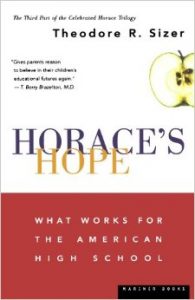Eileen Landay on Horace’s Hope: What Works for the American High School
The final chapter of Horace’s Hope, appropriately titled Horace’s Hope, opens with a description of a day in the life of two high school students, one in “smart suburbia,” the other in a “working-class neighborhood school.” In both settings, the students Ted Sizer shadowed and profiled in the book were essentially silent and passive as they moved from class to class during the day, unengaged, unchallenged and fundamentally unknown to the adults in their schools.
As a veteran teacher who had become a teacher of teachers, reading this book in the late 1990s, I found the description hauntingly accurate. Since my home base at the time was the Education Department at Brown University, one would have thought otherwise. But the established patterns of what it means to teach and what it means to learn are so powerful and pervasive that teachers and students alike are inexorably drawn to what we dismissively called—but often practiced—“mug and jug” teaching, where the teacher at the front of the room pours knowledge into students whose role is to sit, silent and passive, taking it all in.
So pervasive and challenging was this paradigm that when one day the then-department chair, Cynthia Garcia Coll, stood in the door of my office in Barus Hall and asked. “What would you do if you had some modest resources to change the experience of your young teachers and their students?” I heard myself replying without hesitation, “Find ways to get students out of their seats and onto their feet. Bring in artists and actors to create partnerships with teachers. Make things together! Do things! Practice and share.” To my surprise, the resources were forthcoming and colleagues and I created an organization whose principles and practices followed the design described in Horace’s Hope and other Coalition writing. Our core idea was to create a clear and flexible framework for integrating the arts and academic content and to bring educators together to practice, refine and share examples of the framework across sites. We called the enterprise The ArtsLiteracy Project. In the years since its beginning in 1998, the framework we named The Performance Cycle, has been adopted in multiple sites across the country and beyond. Looking at the myriad ways that it has been modified and adapted, we believe that Horace Smith and teachers like him would approve, put it to use and view it as the kind of project that offers reason to hope.
A long-time public school classroom teacher, Eileen Landay was the Clinical Professor of English Education at Brown University from 1993 to 2006 and, in 1998, the co-founder of The ArtsLiteracy Project. Currently a Visiting Scholar at Brown and a literacy and arts integration consultant to schools and districts, she is the co-author of A Reason to Read: Linking Literacy and the Arts.
| The third volume in the Horace trilogy, Horace’s Hope: What Works for the American High School, by Theodore R. Sizer, was published in 1996. Widening the scope of the previous books, Horace’s Hope notes progress and innovations made by schools selected from among the members of the Coalition of Essential Schools, and at the same time identifies obstacles to bringing such reforms to scale. In order to create more widespread school transformation, Sizer urges education systems to empower teachers while diminishing bureaucracy, to expand learning opportunities beyond the classroom, to create more specialized and focused educational options for all students, to move to statewide rather than local funding systems, and other shift in policy and practice. |

